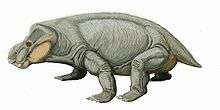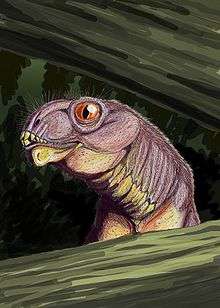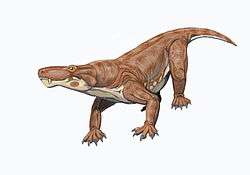Neotherapsida
| Neotherapsida Temporal range: Middle Permian–Holocene, 270–0 Ma (range includes mammals) | |
|---|---|
 | |
| Oligokyphus | |
| Scientific classification | |
| Kingdom: | Animalia |
| Phylum: | Chordata |
| Clade: | Synapsida |
| Order: | Therapsida |
| Clade: | Eutherapsida |
| Clade: | Neotherapsida Hopson, 1999 |
| Subgroups | |
| |
Neotherapsida is a clade of therapsids. It includes anomodonts and the more derived theriodonts, which include mammals.
Distribution
Permian
In the Permian time period, Neotherapsids lived in Germany, India, Madagascar, Niger, South Africa, Tanzania, United Kingdom, United States in Texas, and Zambia.[3]
Severodvinian
In the Severodvinian age of the Tatarian stage of the Permian time period, Neotherapsids lived in Russia.[3][4]
Triassic
In the Triassic, Neotherapsids lived in Antarctica, Argentina, Brazil, China, Germany, Lesotho, Morocco, Poland, Russia, South Africa, Tanzania, and United States in Arizona, Colorado, New Mexico, North Carolina, Texas, Utah, and Wyoming.[3]
Jurassic
In the Jurassic time period, the Neotherapsids lived in Lesotho.[3]
Cretaceous
In the Cretaceous period, the Neotherapsids lived in Australia and Russia.
Classification
The Neotherapsida was classified as a sub group of the clade Eutherapsida by J. A. Hopson in 1999.[3]
Relatives
Taxonomy
Anomodontia



- SUBORDER ANOMODONTIA
- (unranked)Venyukoviamorpha
- Family Otsheridae
- Family Venyukoviidae
- Infraorder Dromasauria
- Family Galeopidae
- Infraorder Dicynodontia
- Family Endothiodontidae
- Family Eodicynodontidae
- Superfamily Kingorioidea
- Family Kingoriidae
- Diictodontia
- Superfamily Emydopoidea
- Family Cistecephalidae
- Family Emydopidae
- Superfamily Robertoidea
- Family Diictodontidae
- Family Robertiidae
- Superfamily Emydopoidea
- Pristerodontia
- Family Aulacocephalodontidae
- Family Dicynodontidae
- Family Kannemeyeriidae
- Family Lystrosauridae
- Family Oudenodontidae
- Family Pristerodontidae
- Family Shansiodontidae
- Family Stahleckeriidae
- (unranked)Venyukoviamorpha
Groups of Theriodontia


